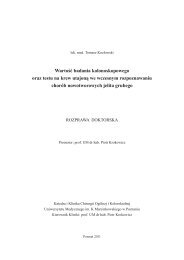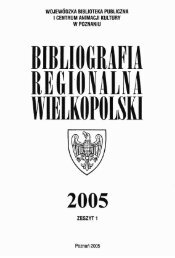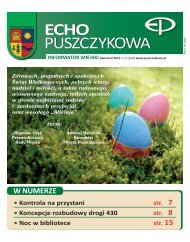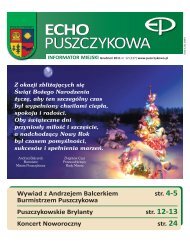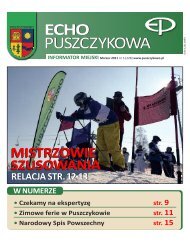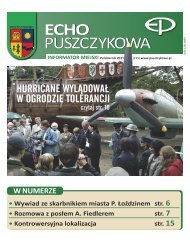MILITARY PHARMACY AND MEDICINE
MILITARY PHARMACY AND MEDICINE
MILITARY PHARMACY AND MEDICINE
Create successful ePaper yourself
Turn your PDF publications into a flip-book with our unique Google optimized e-Paper software.
© Military Pharmacy and Medicine • 2012 • 4 • 61 – 66Jerzy Bertrandt at al.: Sodium and potassium content of daily food rations …PhysiologySodium and potassium content of daily food rations of studentsof the Main School of Fire Service in WarsawAnna Kłos 1 , Maryla Długaszek 2 , Jerzy Bertrandt 1 , Wiesława Szymańska 31Department of Hygiene and Physiology, Military Institute of Hygiene and Epidemiology, Warsaw, Poland.2Institute of Optoelectronics, Military Institute of Technology, Warsaw, Poland.3Department of Health, Ministry of Interior, Warsaw, Poland.Author’s address:Jerzy Bertrandt, Military Institute of Hygiene and Epidemiology, Kozielska 4, 01-163 Warsaw, Poland;phone: (+48) 22 685 31 34, 601 853 117, e–mail: J.Bertrandt@wihe.waw.pl.Received: 2012.11.10 • Accepted: 2012.11.22 • Published: 2012.12.08Summary:Introduction:Besides carbon, hydrogen, nitrogen and oxygen, human body contains about 60 other elements,most of which are classified as minerals. They account for ca. 3% of body weight in neonatesand about 4% of body weight in adults. Since human body is unable to synthesize minerals, they haveto be supplied with food in appropriate amounts and ratios. Among macroelements, i.e. elements withhuman body content of more than 0.01% and safe or recommended intake of more than 100 mg, sodium(Na) and potassium (K) play a particular physiological role.Material and methods: The goal of the study was to assess the content of potassium and sodium in dailyfood rations (DFRs) dispensed for consumption and actually consumed by the students of the MainSchool of Fire Service (MSFS) in Warsaw. The study material consisted of daily food rations dispensedfor consumption to MSFS students. Sodium and potassium content in analyzed samples was determinedby atomic absorption spectrometry (AAS).Results: Mean sodium content of the analyzed DFRs was 7,039.4 ± 1,097.6 mg, compared to 6,271.1 ± 996.2mg in actually consumed meals. Mean potassium content of the analyzed DFRs was 3,477.7 ± 637.2 mgActually consumed rations included 3,099.1 ± 550.6 mg of potassium. Sodium and potassium supplywas different in individual months of the study.Conclusions: The sodium content of daily food rations both dispensed for consumption and actuallyconsumed was several times higher than the recommended standards. The potassium content of dailyfood rations was lower than the standard value. Rations dispensed for consumption covered 99.4%,while rations actually consumed covered 88.9% of the standard demand. Attempts should be made toreduce the sodium intake by raising consumers' awareness of the detrimental health effects of excess saltand by appropriately selecting the products included in the diet.Key words: sodium, potassium, food ration.IntroductionCivilization brings many threats to the quality ofhuman nutrition and contributes to the developmentof bad nutritional habits in the population.http://military.isl-journals.comAccording to the World Health Organization,inappropriate nutrition at young age significantlyimpacts the development of numerouschronic non-infectious diseases at adult age. This61



